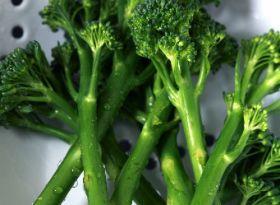
Sales of premium brassica Tenderstem have gone from strength to strength since the Chinese kale-broccoli hybrid was launched back in 2002. Last year the brassica reached the 10 million kg milestone after volume sales grew by a record 14 per cent compared to 2016, and with the vegetable now featured on countless restaurant menus, it has a formidable reputation to uphold.
It is the strength of this reputation that explains why frozen Tenderstem, launched in December last year, took quite so long to develop – a decade to be precise. “We can’t do anything that might damage the brand,” says Coregeo’s chief marketing officer Michelle Evans. “The quality of fresh Tenderstem is really important, so we had to make sure the frozen offering delivered the same eating experience, or as near as possible.”
Several frozen vegetable suppliers have presented Coregeo with product samples over the past 10 years. And Evans says the company did a “huge amount” of tinkering and testing before Kenyan frozen specialist TSA International finally cracked the code, after beginning trials in 2014.
Problems with excessive water retention were a stumbling block in the product’s development, according to TSA’s general manager Sarah Jackson, recalling that in earlier trials water would drip out of the stem when squeezed. “Peas have shells all the way around the outside so water can’t get in when you freeze them, but with Tenderstem, where you cut the stalk at the bottom, water is more easily absorbed,” she explains.
During testing, TSA tried out all the main cooking methods used for Tenderstem – boiling, steaming, griddling and roasting – stressing that customers who already cook it fresh want to be able to prepare frozen product in the same way. Conveniently, since each stem is frozen individually, people cooking for one can easily take out just a few stems at a time, helping to avoid food waste.
Other key benefits of the product are its cost and smaller carbon footprint, according to TSA’s managing director Tiku Shah. Unlike fresh Tenderstem, which is sent from Kenya to the UK by airfreight during the off-season, frozen Tenderstem can be transported cheaper by sea. This keeps down prices while also lessening the environmental impact. And at £1.79 for a 270g pack at Iceland, it is considerably cheaper than fresh Tenderstem, which costs around £2 for 200g at most supermarkets.
This lower price point, and the decision to launch the product at Iceland, are indications that Coregeo is trying to tap into a new channel and reach a new demographic of consumers. “You can’t say that all Tenderstem customers are of a particular type,” Evans says, “but they tend to be young professionals or empty nesters – people with more time or money to spend on gourmet veg. I think this frozen offering makes Tenderstem more viable for the everyday family.”
Many shoppers assume there are compromises to be made when buying frozen produce. However, at a nutritional level, recent research suggests otherwise. A 2014 study by the Department for Food Science at the University of California found no consistent differences between nutrient levels in eight fresh and frozen vegetables, including broccoli, which actually contained more riboflavin if frozen.
Proponents of frozen fruit and veg argue that freezing locks in vitamins and minerals, whereas fresh vegetables gradually lose nutrients the moment they are harvested. Importantly, TSA freezes its stems just six to eight hours after they are picked to minimise nutrient loss, and Coregeo is carrying out tests of its own to see how the nutritional value of its frozen Tenderstem compares to that of fresh. One thing that can be guaranteed is a longer shelf life, with frozen Tenderstem staying in date for a full two years.
To support the product’s launch at Iceland, Coregeo has run its biggest-ever marketing campaign with a retailer. It covers digital and native advertising, with a video on YouTube, ads on Gmail and pay-per-click advertising against particular search words on Google. Evans says the brand doesn’t have any sales expectations as such, but she has been encouraged by the response so far: “If the reaction we’ve had on social media is any indication, I think the sky’s the limit,” she says.
Coregeo says it will spend the next few months seeing how sales progress at Iceland, while trying to “understand the customer a little better”. In the longer term, the company has ambitions to launch frozen Tenderstem in other retailers and across other countries in Europe and beyond.
Crucial to the product’s success will be its ability to appeal to a new segment of retail consumers, with perhaps less money and prior knowledge of Tenderstem. But with a smaller price tag, a convenient offering and a strong brand identity behind it, Coregeo can be confident frozen Tenderstem will be worth the time and effort it took to create.
Growing the brand
Tenderstem (for freezing) is grown by TSA International in Kenya’s Rift Valley, north west of Nairobi, at altitudes of around 2,000m. Lying directly on the equator, the sun is up for around 12 hours a day year round, but the growing process is adapted during the wet season to ensure uniformity in flavour, colour and stem. A key challenge when growing for frozen is harvesting the brassica at “full maturity, full colour, full flavour, and with all the goodness and nutrition captured,” Shah says.



